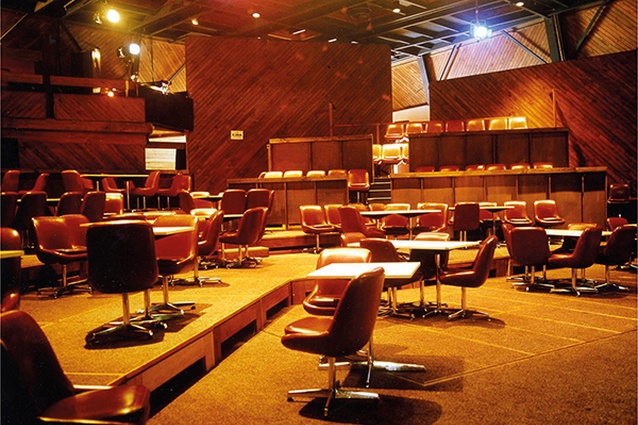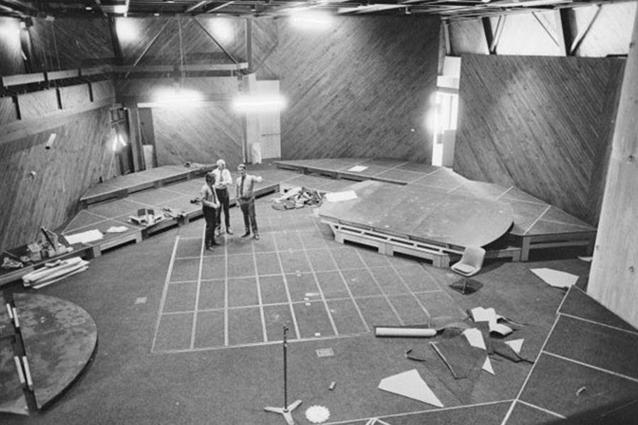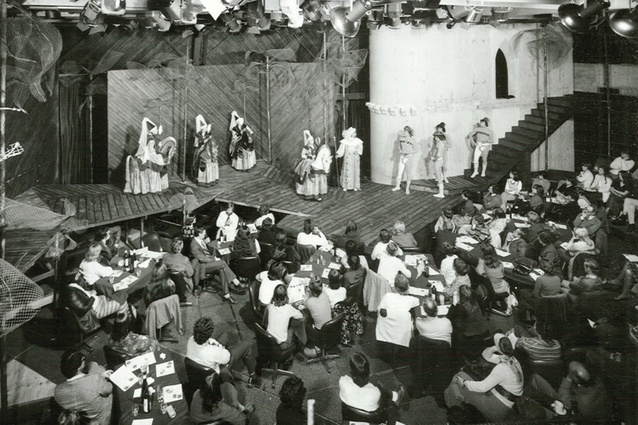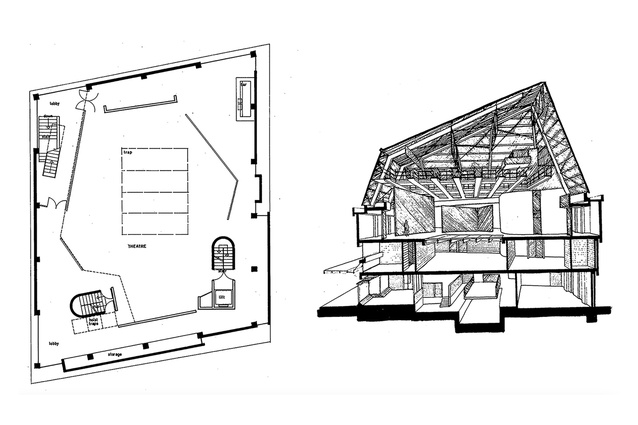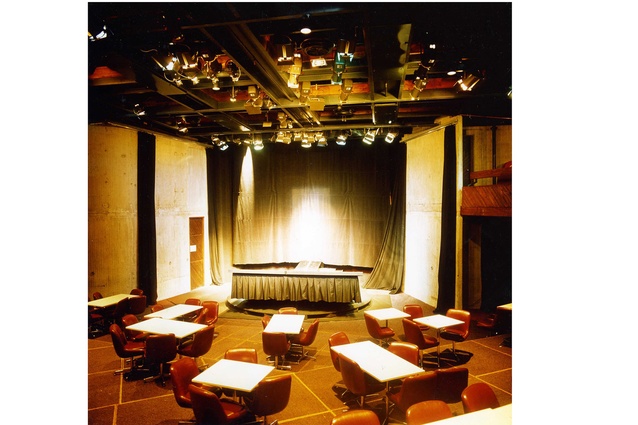The Hannah Playhouse: Theatre architecture as enduring event
This year’s arts festivals in both Wellington and Auckland were distinguished by a superb New Zealand theatre work, Gravity and Grace, developed in Wellington’s Hannah Playhouse, now referred to as The Hannah. Although focusing on the portrayal of spectacular creative failure, the show was, in fact, a masterpiece of contemporary intermedial design: seamlessly integrating performing bodies with setting, sound, lighting and moving image; including live camera feed overlaid from varying angles.
It is not usual for the premiere of national productions to shine so brightly in our arts festivals. Too often dominated by the well-honed productions brought in from overseas, new works tend to languish as one-off presentations due to limited funds and spaces for developmental workshops. I would suggest that the success of Gravity and Grace – by award-winning duo Eleanor Bishop and Karin McCracken (EBKM) – owes a lot to the performance design presided over by Meg Rollandi, as well as the company’s crucial access to a well-equipped venue in which to incubate and develop such technically innovative work.
Last October, Aotearoa’s performing arts community gathered in The Hannah to celebrate 50 years since its official opening, which coincided with the building receiving a Category 1 listing from Pouhere Taonga Heritage NZ. Such a critical distinction ensures the theatre’s longevity after languishing with an uncertain future for over a decade (albeit temporarily occupied by Capital E’s National Theatre for Children and Tawhiri Festival’s works in development). Thanks to the dedication and determination of the Hannah Playhouse Trust working with Wellington City Council, this important architectural landmark for Pōneke now operates as a performance laboratory made available to a diverse range of mid- and senior-career artists and organisations to develop their professional skills and creative outputs.
As a celebrated example of 1960s Wellington brutalism – the signature style of its proclaimed architect James Beard (1927–2017) – The Hannah has resolutely stood for half a century on the corner of Courtenay Place and Cambridge Terrace. It was first reviewed by another of the city’s modernist architects, Helmut Einhorn, who described the building as a character pulling its hat down against the wind.[1] This refers to the asymmetric wedge-shaped steel roof sitting atop two muscular concrete facades on a rhomboid-shaped site, which Einhorn hailed as a miraculous feat: “It is impossible to think of any other place where a site like this would have been considered for use as a theatre”.[2]
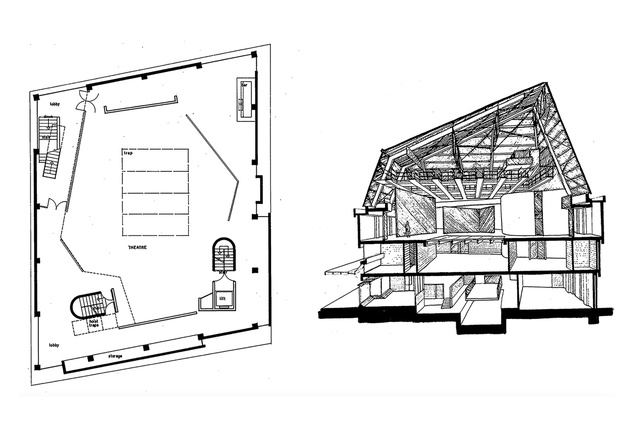
The parallelogram footprint led to the design of a uniquely shaped auditorium nestled on the top floor, which challenges all expectations of auditorium design. Definitively architectural, it is irregularly composed of angled concrete stair towers and cranked walls of diagonally slatted timber forming upper-level seating galleries that sit over peripheral circulation. Inviting a range of actor-audience relationships, the venue was originally designed as a restaurant theatre with a flexible rostra system that created a limitless range of terraced formats for dining and multiple staging. The surrounding ambulatory below enhances flexibility by providing spectators and performers with a range of entry and exit points. As an interstitial zone, it also momentarily disorients the public, which moves from the everyday world to one that folds the fictive environment of the performance with the inescapable and, to many who have worked in it, challenging character of the theatre’s architecture. This is far from the orthogonal archetype of modernism’s featureless black box, which continues to dominate theatre interiors through a general desire for dark neutrality out of which manifold worlds can be conjured.
Designed as a home for Downstage Theatre Company, which occupied the site for nearly half a century before folding in 2013, the nuggety 1970s building has always elicited strong responses from the public and performance professionals alike. While the upper-level auditorium was devised to allow for ground-floor rental space, and a mid-level rehearsal room – later transformed into a bar – facilitates access to floor hatches in the stage floor, the initial lack of an elevator and a limited slot for hoisting scenery from the street dock have compromised ease of access for both audiences and technicians.
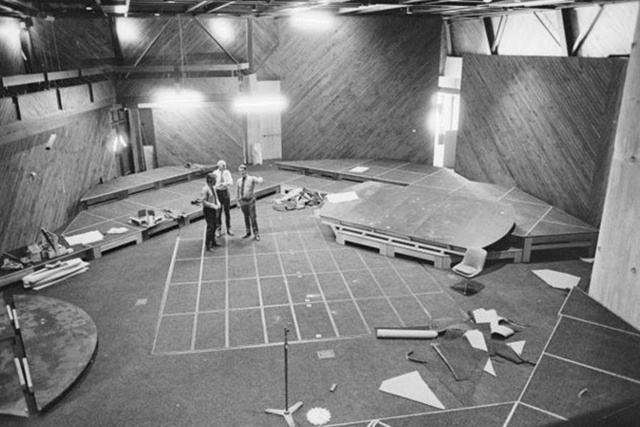
The cumbersome rostra for seating and staging required considerable time and labour (often provided by actors, crew and volunteers) for changing formats until issues around costs and unionisation made it increasingly prohibitive to experiment with spatial relationships, especially after dining ceased in the 1980s. This led to an increasing deferral to the traditional end-stage format facing the cranked concrete towers that formed a tight proscenium. The interior’s emphatic materiality – often regarded as spatially dominant – was frequently cloaked in black drapes, resulting in bland conventional neutrality compromised by the curious geometry. However, the most innovative productions have accepted rather than resisted this quirky space over the years, embracing its character as part of the designed landscape and investigating its potential.
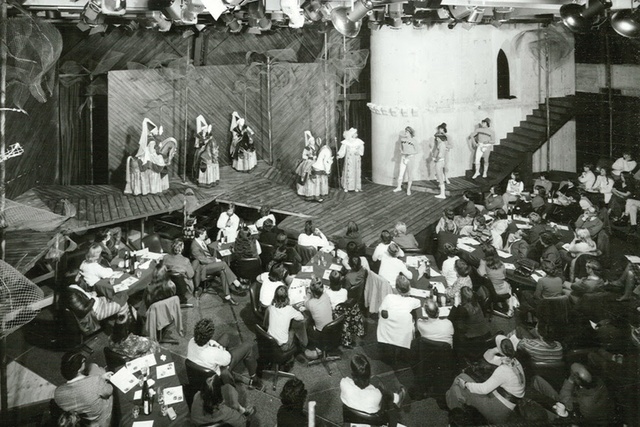
This is an architecture born out of a shared desire for radical experimentation initiated by those who established Downstage Theatre Company back in 1964 – namely poet Peter Bland, striving actors Tim Elliott and Martyn Sanderson, and cultural entrepreneur Harry Seresin. It began with what Peter Harcourt calls “coffee-table talk” in Seresin’s Coffee Gallery at Massey House on Lambton Quay where the four men discussed “a friendly, conversational, intimate and hospitable sort of theatre, with refreshments (soup? sandwiches? beer?) as well as a stage for performance.”[3] This led to securing the abandoned Walkabout Café on the corner of the current site where a 60-seat dinner theatre was established.
In true Kiwi fashion, it was named Downstage to counter the notion of upstaging or over-reaching: focusing on an informal, flexible and egalitarian identity that eschewed the artifice of proscenium arch theatre while promoting a relaxed atmosphere for encouraging discussions before and after the shows. The tiny community-focussed café eventually extended next door and upstairs (with storage found in the decommissioned ‘Taj Mahal’ public toilet on the adjacent median strip), while increasing demand led to productions in larger venues around the city. It became clear that a bespoke company home was in order, coinciding with the city’s need to spend a generous donation made by Sheilah Winn (of Hannah Shoes fortune) towards a ‘small and intimate’ theatre.
The desire for a new, modern and distinctive space, rather than a multi-purpose hall, was expressed in an improvised sketch by scenographer Raymond Boyce – proposing a flexible 150-300-seat auditorium embraced by ‘terraces’ for upper-level seating – which impressed Winn. Boyce then worked as theatre designer with Auckland-based architect Ron Parker (also a set designer) on the initial design before local architecture firm Gabites and Beard were commissioned to develop the project as a dinner theatre, which was completed in 1973, opening with a production of Shakespeare’s As You Like It.
Described by David Carnegie as “one of the most flexible purpose-built theatre homes for a resident professional theatre company anywhere in the world”[4] – which was changed by the editor to “anywhere in the country” [5] – the Hannah Playhouse is indeed a globally unique venue. This is due more to its dynamic auditorium than the brutalist architecture that has gained multiple tributes, including the New Zealand Institute of Architects Award in 1978 and the Award for Enduring Architecture in 2006.
In 2001, the specialist theatre architecture consultancy firm I worked for in New York invited Jean-Guy Lecat – a Paris-based technical director and scenographer responsible for helping shape a range of significant permanent and temporary theatres in Europe and further afield – to run a brief workshop. Having discussed the notable spaces he created with renowned English director Peter Brook for the International Centre for Theatre Creation (CIRT), Lecat was asked if there are any venues he admired that he had not collaborated on, to which he answered, “The Hannah Playhouse in Wellington”. This adaptable 250-seat theatre is one of a handful of asymmetric performance spaces in the world, which is both flexible and decisively architectural, conforming to Peter Brook’s notion of An Open Circle, expressed in the book Lecat co-authored with Andrew Todd as “at once rough and dignified, free and precisely balanced”.[6]
In his celebrated theatre treatise, The Empty Space, Brook wrote:
“I have had many abortive discussions with architects building new theatres—trying vainly to find words with which to communicate my own conviction that it is not a question of good buildings and bad: a beautiful place may never bring about explosion of life; while a haphazard hall may be a tremendous meeting place… The science of theatre-building must come from studying what it is that brings about the most vivid relationship between people—and is this best served by asymmetry, even by disorder?”[7]
He then goes on to claim that “An architect is better off if he [sic] works like a scene designer”.[8] It is therefore no coincidence that Brook’s highly successful theatres have included the collaboration of Lecat and Greek-born scenographer Chloé Obolensky. The power and presence of The Hannah’s auditorium – perhaps saved by the Heritage Listing from being gutted and painted black as suggested by some of its detractors over the years – owes much to the virtuosity and inventiveness of Raymond Boyce (MBA). Richard and Edith Campion persuaded him to move from England to join their New Zealand Players, the country’s first professional theatre company, formed in 1953 and disbanded in 1960. Downstage itself was instigated by part-time actors, forced (as with many New Zealand theatre artists today) to make a living elsewhere, and Boyce is one of a handful of professional designers in our history who has made a consistent living out of designing live theatre. Like Brook, he understood that The Empty Space is not a black box, but a room shaped for dynamic encounters between performers and audience: a material place that offers both resistance and reciprocity; in short, a space that itself performs within the event – as an event.
The history of New Zealand theatre architecture could be considered a small one, while that of Aotearoa goes back to the Whare Tapere (House of Entertainment), which was an inherent part of the village life of a Pā. Māori scholar Te Ahukaramū Charles Royal refers to this pre-European form as “iwi-community ‘houses’ of storytelling, dance, music, puppets, games and other entertainments”: briefly occupying communal houses or most simply taking place outdoors; next to the communal fire, under a large tree or in an open space.[9] So it’s very likely there was a whare tapere as part of the Te Aro Pā on the shoreline of Te-Whanganui-a-Tara – very near where The Hannah now stands – before the land was purchased by The New Zealand Company in 1839 for Pākehā settlement and the Pā eventually abandoned.
In 1843 the first settler theatre was established a kilometre away on the corner of Manners and Willis Streets in Barry’s Ship Hotel, described by the Spectator newspaper as “mixing up the boisterous uproar of the taproom with rational amusements, in which all classes and individuals of both sexes and all ages meet together,”[10] echoed over a century later by those who initiated Downstage’s desire for an affable democratic venue combining performance with food and beverages. 180 years after the improvised pub theatre, the country’s performing arts communities continue to battle what the hotel theatre’s impresario back then described as “our slender means, our limited resources, and the great paucity of appliances necessary for the erection of a theatre.”[11]
This infrastructure impoverishment could be seen in the current state of affairs: the ongoing uncertainty of Auckland’s historic St James Theatre; the University of Auckland’s delay in replacing Warren and Mahoney’s award-winning Maidment Theatre that it summarily demolished in 2016; and the current lack of a venue for Dunedin six years after the Fortune Theatre Company folded, closing the degenerating stone church it had occupied for 40 years. Although it took until 1973 to build the Hannah Playhouse as the country’s first bespoke standalone professional venue, it was an impressive achievement, as was recently saving it from an unknown fate. Although we’ve seen many venues closed, demolished or at risk, hope lies in projects such as the recent ASB Waterfront Theatre (Auckland Tāmaki Makaurau 2016) and kaupapa Māori venue Te Pou Theatre (Auckland Tāmaki Makaurau 2021), alongside the soon-to-be-completed Waikato Regional Theatre (Hamilton Kirikiriroa) and Court Theatre (Christchurch Ōtautahi). But none have been as unique and conceptually rigorous as The Hannah.
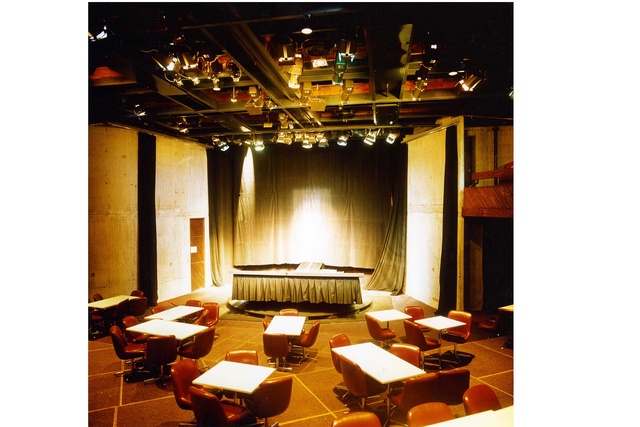
The Hannah is defined by design acumen – both in its architecture and the scenography it elicits – as well as manaakitanga, emphasising nourishment, nurture and protection, which are expressed in its origins around dining. Through the social act of sharing food and performance, the building was conceived around sensory social exchange. While the downstairs tenanted restaurant and Halfway Up Bar subsidise creative activities, providing hospitality for events, the current manaaki lies in providing space for creative research and development rather than commercial profit. A new flexible rostra system enables seating formats to be rearranged in six hours by a crew of four, supporting and encouraging spatial experimentation hitherto considered generally unaffordable.
Theatre infrastructure is critical to supporting and enriching exciting new work in Aotearoa, which enables recognition further afield. The Hannah’s current three-year pilot program offers space for meaningful design-led practice, enabling technological experimentation and dynamic encounters with diverse audiences. Successful productions such as Gravity and Grace benefit from a kaupapa of diversity and accessibility. This has returned the gravity of a demanding brutalist architecture alongside the grace of its flexibility to New Zealand’s ever-struggling performing arts community in order to – as former Downstage Director Martyn Sanderson stated back in 1966 – “celebrate the triumph of imagination over the lack of money.”[12]
[1] Helmut Einhorn (1973). Review reproduced in Hannah Playhouse Wellington, James Beard & Co. Held in the National Library: ref, PAColl-9938-1.
[2] Ibid.
[3] Peter Harcourt (1978). A Dramatic Appearance: New Zealand Theatre 1920-1970. Methuen NZ, p. 148
[4] David Carnegie (2024) Re: hello and a quick question. Email reply to Dorita Hannah: 02/04/2024, 1:52pm
[5] David Carnegie (2001). ‘New Zealand’ in The World Encyclopaedia of Contemporary Theatre 2001, Vol 5. Edited by Don Rubin et al., p350.
[6] Lecat and Todd (2003). The Open Circle: Peter Brook’s Theatre Environments. Faber & Faber.
[7] Peter Brook (1968). The Empty Space. Touchstone, p78.
[8] Ibid., p79.
[9] Te Ahukaramū Charles Royal website: https://www.charles-royal.nz/whare-tapere#:~:text=Whare%20Tapere%20are%20iwi%2Dcommunity,iwi%20life%20throughout%20New%20Zealand. Royal’s PhD dissertation, Te Whare Tapere: Towards a New Model for Māori Performance Art, is lodged in the Te Herenga Waka / University of Wellington Library.
[10] Peter Downes (1975). Shadows on the Stage: Theatre in New Zealand – the first 70 years. John McIndoe – Dunedin, citing the Spectator, p14.
[11] James Marriott ‘s opening address on 12 September 1843, cited by Downes, p15.
[12] John Smythe (2004). Downstage Upfront: The First 40 Years of New Zealand’s Longest Running Professional Theatre. Victoria University Press. Citing Martyn Sanderson’s final report as Director of Downstage, p52.


